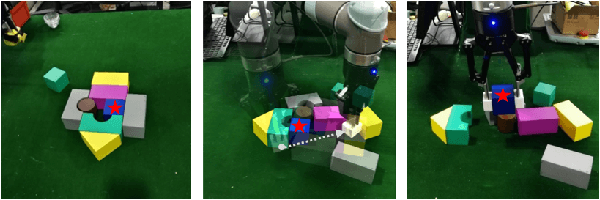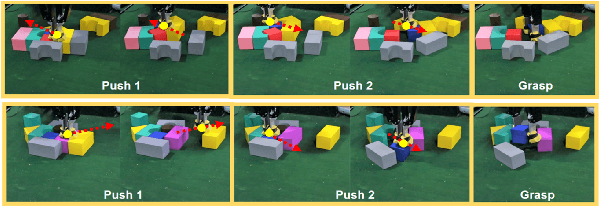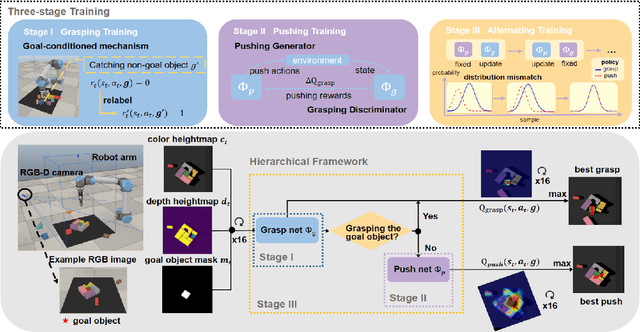Qianen Lai
Efficient learning of goal-oriented push-grasping synergy in clutter
Mar 09, 2021



Abstract:We focus on the task of goal-oriented grasping, in which a robot is supposed to grasp a pre-assigned goal object in clutter and needs some pre-grasp actions such as pushes to enable stable grasps. However, sample inefficiency remains a main challenge. In this paper, a goal-conditioned hierarchical reinforcement learning formulation with high sample efficiency is proposed to learn a push-grasping policy for grasping a specific object in clutter. In our work, sample efficiency is improved by two means. First, we use a goal-conditioned mechanism by goal relabeling to enrich the replay buffer. Second, the pushing and grasping policies are respectively regarded as a generator and a discriminator and the pushing policy is trained with supervision of the grasping discriminator, thus densifying pushing rewards. To deal with the problem of distribution mismatch caused by different training settings of two policies, an alternating training stage is added to learn pushing and grasping in turn. A series of experiments carried out in simulation and real world indicate that our method can quickly learn effective pushing and grasping policies and outperforms existing methods in task completion rate and goal grasp success rate by less times of motion. Furthermore, we validate that our system can also adapt to goal-agnostic conditions with better performance. Note that our system can be transferred to the real world without any fine-tuning. Our code is available at https://github.com/xukechun/Efficient goal-oriented push-grasping synergy
Cellular Decomposition for Non-repetitive Coverage Task with Minimum Discontinuities
Jan 27, 2020



Abstract:A mechanism to derive non-repetitive coverage path solutions with a proven minimal number of discontinuities is proposed in this work, with the aim to avoid unnecessary, costly end effector lift-offs for manipulators. The problem is motivated by the automatic polishing of an object. Due to the non-bijective mapping between the workspace and the joint-space, a continuous coverage path in the workspace may easily be truncated in the joint-space, incuring undesirable end effector lift-offs. Inversely, there may be multiple configuration choices to cover the same point of a coverage path through the solution of the Inverse Kinematics. The solution departs from the conventional local optimisation of the coverage path shape in task space, or choosing appropriate but possibly disconnected configurations, to instead explicitly explore the leaast number of discontinuous motions through the analysis of the structure of valid configurations in joint-space. The two novel contributions of this paper include proof that the least number of path discontinuities is predicated on the surrounding environment, independent from the choice of the actual coverage path; thus has a minimum. And an efficient finite cellular decomposition method to optimally divide the workspace into the minimum number of cells, each traversable without discontinuties by any arbitrary coverage path within. Extensive simulation examples and real-world results on a 5 DoF manipulator are presented to prove the validity of the proposed strategy in realistic settings.
 Add to Chrome
Add to Chrome Add to Firefox
Add to Firefox Add to Edge
Add to Edge